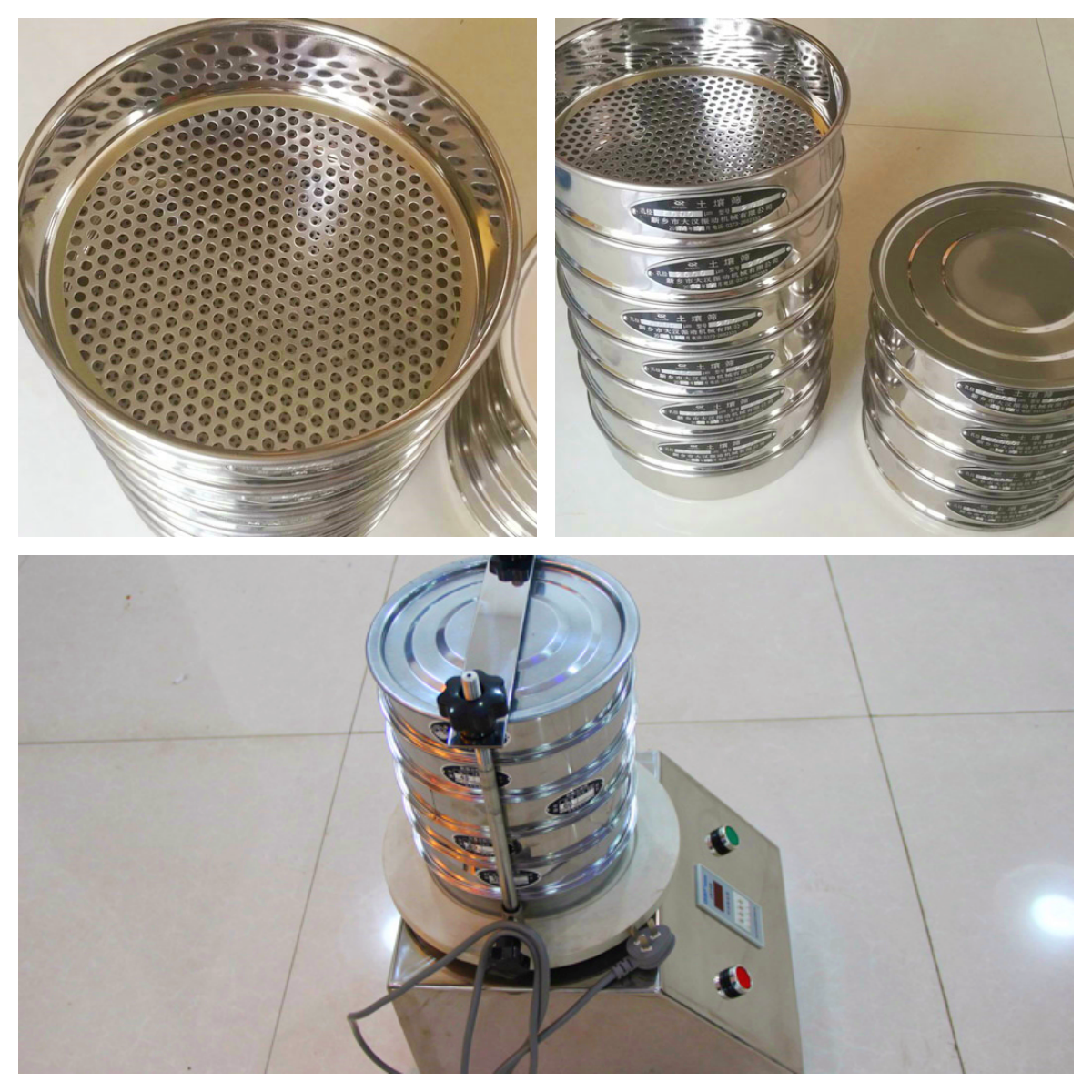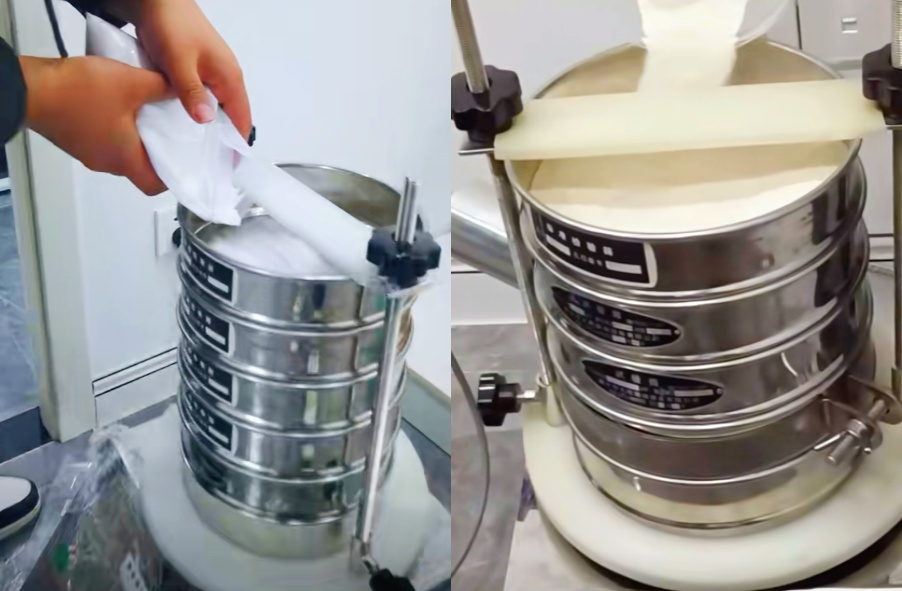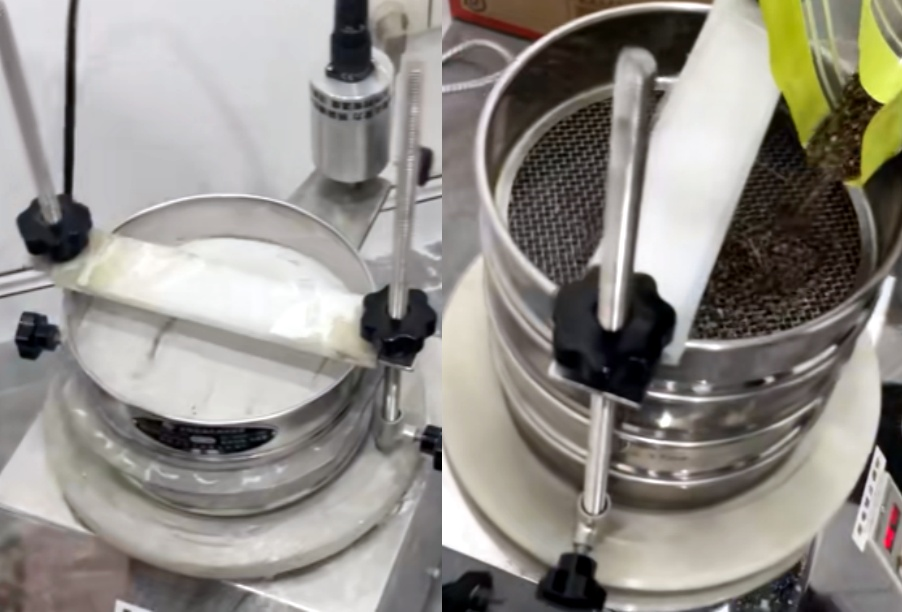Saturday June-07 2025 17:23:36
Fine aggregate test sieve is a special instrument for determining the particle gradation of fine aggregates such as sand and stone chips with a particle size not greater than 4.75mm. Due to the small particle size and large specific surface area of fine aggregate, its particle gradation and particle size distribution directly affect the engineering properties such as concrete workability and asphalt mixture adhesion, so it needs to be accurately screened through a test sieve.

Commonly used sieves use square hole sieves, and the sieve meshes include 9.5mm (oversize screening), 4.75mm, 2.36mm, 1.18mm, 600μm, 300μm, 150μm, 75μm and other sieve hole sizes. The sieve holes are stacked from top to bottom according to the aperture size from large to small, and the bottom plate and top cover form a complete screening system.
Fine aggregate test sieve and coarse aggregate screening analysis are both important methods for aggregate (aggregate) particle size analysis, but they have significant differences in definition, sieves used, sample size and test purpose. Understanding these differences is crucial for accurately evaluating aggregate quality and engineering design.
Fine aggregate: usually refers to aggregate with a particle size less than 4.75mm, including natural sand, machine-made sand, stone chips, etc. In some standards, 5mm may also be used as the dividing point between coarse and fine aggregates.

Coarse aggregate: usually refers to aggregate with a particle size of not less than 4.75mm, including crushed stone, gravel, pebbles, etc.
|
Features |
Sieving analysis of fine aggregate |
Sieving analysis of coarse aggregate |
|
Aggregate type |
Natural sand, machine-made sand, stone chips, etc. |
Crushed stone, gravel, pebbles, etc. |
|
Sieve aperture range |
Mainly use sieves smaller than 4.75mm, such as: 4.75mm, 2.36mm, 1.18mm, 0.60mm, 0.30mm, 0.15mm, 0.075mm |
Mainly use sieves larger than 4.75mm, such as: 4.75mm, 9.5mm, 16mm, 19mm, 26.5mm, 31.5mm, 37.5mm, 53mm, 63mm, 75mm, etc. |
|
Minimum sieve aperture |
Usually to 0.075mm sieve (200 mesh sieve), used to determine mud content or stone powder content. |
Usually to 4.75mm sieve, the amount passing through is classified as the fine aggregate part and is not further subdivided |
|
Sieve group order |
The sieve apertures are stacked in order from large to small (4.75mm is on the top). |
The sieve holes are stacked from large to small (the largest particle size sieve is on the top layer) |
The fine aggregate test sieve is mainly composed of sieve frame, sieve mesh, sieve cover and sieve bottom:

Sieve frame: usually a round stainless steel structure with a diameter of 200mm or 300mm.
Sieve mesh: copper mesh or stainless steel wire mesh with high aperture precision, ranging from 0.075mm to 4.75mm, commonly used apertures include: 4.75mm (No. 4 sieve), 2.36mm (No. 8 sieve), 1.18 mm (No. 16 sieve), 0.6 mm (No. 30 sieve), 0.3 mm (No. 50 sieve), 0.15 mm (No. 100 sieve), 0.075 mm (No. 200 sieve)
Sieve cover and sieve bottom: used to close the sieve to prevent sample overflow.
|
Mesh number (mesh) |
Sieve hole diameter (mm) |
Remarks |
|
4 |
4.75 |
Commonly used as coarse and fine boundary sieve |
|
8 |
2.36 |
Coarse sand sieve hole |
|
16 |
1.18 |
Medium and fine sand sieve hole |
|
30 |
0.60 |
Fine sand sieve hole |
|
50 |
0.30 |
Fine sand and silty component sieve hole |
|
100 |
0.15 |
Very fine particle sieve hole |
|
200 |
0.075 |
fine powder and mud particle sieve |

In concrete engineering, fine aggregates such as sand are screened through the test sieve to determine whether they meet the grading requirements, thereby ensuring the workability, strength and durability of the concrete mixture and avoiding segregation and water seepage due to poor grading of fine aggregates; in asphalt pavement construction, the test sieve can detect the particle composition of fine aggregates (such as stone chips and machine-made sand), control the content of particles below the 0.075mm sieve, and prevent excessive mud powder from affecting the adhesion between asphalt and aggregates.
In addition, in roadbed filling, the test sieve is used to analyze the particle size distribution of fine aggregates, determine whether they meet the needs of roadbed improvement, and optimize the compaction and stability of the soil. Through the precise screening of the test sieve, reliable fine aggregate quality data can be provided for various projects to ensure that the project quality meets the standards.
The purpose of testing fine aggregates is to evaluate whether their quality meets the project requirements to ensure that the performance of building materials such as concrete, mortar or asphalt mixture is stable and reliable.
① Particle grading test (screening test): This is one of the most important tests for fine aggregates, which is used to determine the content of particles of different sizes in fine aggregates, so as to judge whether its grading is reasonable.
Take samples from fine aggregates according to standard methods and reduce them to make the samples representative and reach the required mass for the test. It is usually necessary to dry the samples to constant weight (generally at 105℃~110℃). Accurately weigh the mass of the dried sample (for example, 500g or more, depending on the standard). Stack a set of standard square hole sieves (such as 4.75mm, 2.36mm, 1.18mm, 0.6mm, 0.3mm, 0.15mm, 0.075mm) in order from large to small sieve holes, with the sieve cover on the top and the sieve bottom on the bottom. Pour the sample into the top sieve, cover the sieve cover, and sieve it with a mechanical sieve shaker for 10 minutes (or hand sieve according to standard requirements) until the amount passing through per minute is less than 0.1% of the total sample volume.

② Mud content and mud block content test: Determine the content of harmful impurities such as clay, silt, and organic matter in fine aggregate, which will affect the strength and durability of concrete.
Take a certain mass of fine aggregate sample, put the sample into a container filled with water, soak it in water and stir it thoroughly to separate the mud and powder adhering to the aggregate. After the mud suspension settles for a certain period of time, carefully pour off the upper muddy water. Repeat the washing and pouring process until the upper water becomes clear. Dry the washed aggregate to constant weight and weigh its mass.

The fine aggregate test sieve is a basic tool for evaluating whether the sand particle gradation meets the engineering requirements. Through the standardized screening test process, accurate particle distribution data (cumulative sieve residue percentage, pass percentage) and fineness modulus that characterizes the overall coarseness and fineness can be obtained, providing a vital basis for the mix design and quality control of concrete, mortar, etc. Correct use and maintenance of the sieve and strict compliance with the test procedures are the key to ensuring accurate and reliable screening results.
What is the wet sieving process?
Wet sieving process is a sieving process assisted by a liquid (usually water or a solution containing a dispersant) to more effectively...
Fines content tester can be defined as an instrument used to quantitatively determine the content of fines powder components of a specific fineness...
Micro silica powder particle size analysis test sieve
Micro silica powder, also known as silica fume, is an ultrafine active silica material with a very small particle size, usually between 0.1-0.3 microns, which...
Agricultural gruesos Test sieves
Agricultural gruesos test sieves are experimental equipment used for particle size analysis, grading and testing of agricultural soil, gruesos...
Stainless steel frame and woven cloth
The test sieve is a laboratory equipment used for particle size analysis. Its core components usually include a stainless steel frame and woven cloth (also called a sieve)...
Soil sieving analysis is a soil particle size determination method based on the principle of mechanical separation. It is mainly used to analyze...
Jun 07, 2025
Fine aggregate test sieve is a special tool for analyzing the particle gradation of fine aggregate (s...
Jun 06, 2025
Soil sieving analysis is done by dry or wet sieving, using a series of standard sieves to separate so...
Jun 05, 2025
ASTM standard soil analysis sieves with pan and cover
The main function of the ASTM standard soil analysis sieve (with pan and cover) is to accurately sepa...
Jun 04, 2025
Ultrasonic Sieve test for Juice Powder
Ultrasonic sieve test for juice powder is suitable for screening high-sugar juice powder that is easy...
![]()
Then we look forward to hearing from you
Contact Us
Industrials
Yanjin county forest park gate to the west 1000 meters north road sitemap
